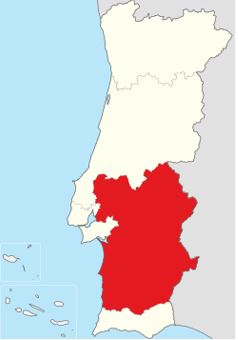In 2019, ANACOM conducted an evaluation study of the performance of mobile voice and data services, and GSM (Global System for Mobile communications - Second generation Mobile Communications System - 2G), UMTS (Universal Mobile Telecommunications System - Third generation Mobile Communications System - 3G) and LTE (Long Term Evolution - Fourth generation Mobile Communications System - 4G) coverage provided by MEO, NOS and Vodafone in the Alentejo region (NUTS II), which fully covers the districts of Portalegre, Évora and Beja, as well as part of the districts of Santarém and Setúbal, comprising a total of 58 municipalities1, covering 31.6 thousand Km2, i.e. 34% of the country's land surface (see Figure 1).

Figure 1 - NUTS II Alentejo.
This study, the first of a set that will cover all regions of the country and which aims to provide the market with impartial information on the performance of these services, was intended to characterise the user experience in terms of accessibility, retention and integrity of services. For this purpose, the following were performed locally by ANACOM: (i) calls and conversations, to assess voice service; (ii) downloads of files, web pages and videos, to assess data services; (iii) measurements of radio network signal levels, to assess coverage; resulting in 13 quality indicators used to measure service performance and radio coverage (see Annex 1).
The systems analysed showed, on average, good GSM radio coverage, adequate UMTS radio coverage and reasonable LTE radio coverage, although with differentiated performances among typologies of urban areas (see Annex 2) and among operators (see Annex 3). The following are also noteworthy:
- As regards the typologies of urban areas, a worse performance in the moderately urban and predominantly rural areas.
- In the analysis of the results associated with each operator and their differences, a better performance of Vodafone in UMTS and LTE radio technologies.
- That the measurements conducted to assess radio coverage have, in most cases, recorded signal levels of "very good" or "good" quality, but also others below the appropriate parameters, notably in LTE, including some significant levels of "non-existent" coverage, in predominantly rural areas.
Voice and file transfer services registered a good overall performance, with more visible differences between operators and between typologies of urban areas in terms of download and upload speed. However, a high variability was registered, with maximum records above 100 Mbps and 50 Mbps, respectively for download and upload, and minimums of around 0.004 Mbps, which make it difficult or impossible to transmit data under appropriate conditions.
Internet browsing and youtube video streaming services, as well as data transmission latency, performed considerably less well than the other indicators under analysis. These indicators also show, in most cases, significant differences between providers and between typologies of urban areas.
This study is based on tests performed according to the new methodology approved by ANACOM in 2017, after consulting the market. Measurements are performed systematically, with standardised procedures and without human intervention or decision, and under equal conditions for the various operators, allowing objective and comparative analysis of performances. In the sampling approach followed, the set of mobile communications carried out in the mainland territory is considered as the universe, with the mobile voice call and the mobile data session being the statistical units considered. The sample is based on two stratification levels. The first separates the mainland territory into NUTS II, followed by a breakdown by NUTS III. The study now released concerns the results obtained from the sample for the Alentejo Region (NUTS II).
The fieldwork for this first study took place between 7 and 28 May 2019, which involved 891 voice calls, 5,853 data sessions and 550,597 radio signal measurements, corresponding to approximately 297 voice calls, 325 data sessions and 61,200 radio signal measurements per indicator and operator. 3,539 kilometres were covered, of which 342 in tests.
It should be stressed that the reading of the results must take account of the dynamic nature and permanent evolution of mobile communication systems.
ANACOM has planned to carry out during the current year the studies relative to the other regions of the continental territory, to be followed by the studies relative to the Autonomous Regions of the Azores and Madeira.
Annex 1 - Quality indicators to measure the performance of services and radio coverage
Annex 2 - Summary of differences between types of urban areas
Annex 3 - Summary of differences between operators
1 Alcácer do Sal, Grândola, Odemira, Santiago do Cacém, Sines, Aljustrel, Almodôvar, Alvito, Barrancos, Beja, Castro Verde, Cuba, Ferreira do Alentejo, Mértola, Moura, Ourique, Serpa, Vidigueira, Almeirim, Alpiarça, Azambuja, Benavente, Cartaxo, Chamusca, Coruche, Golegã, Rio Maior, Salvaterra de Magos, Santarém, Alter do Chão, Arronches, Avis, Campo Maior, Castelo de Vide, Crato, Elvas, Fronteira, Gavião, Marvão, Monforte, Nisa, Ponte de Sor, Portalegre, Sousel, Alandroal, Arraiolos, Borba, Estremoz, Évora, Montemor-o-Novo, Mora, Mourão, Portel, Redondo, Reguengos de Monsaraz, Vendas Novas, Viana do Alentejo and Vila Viçosa.
Consult:
- Evaluation of mobile service performance and coverage of GSM, UMTS and LTE in the region Alentejo (NUTS II) https://www.anacom.pt/render.jsp?contentId=1499819




